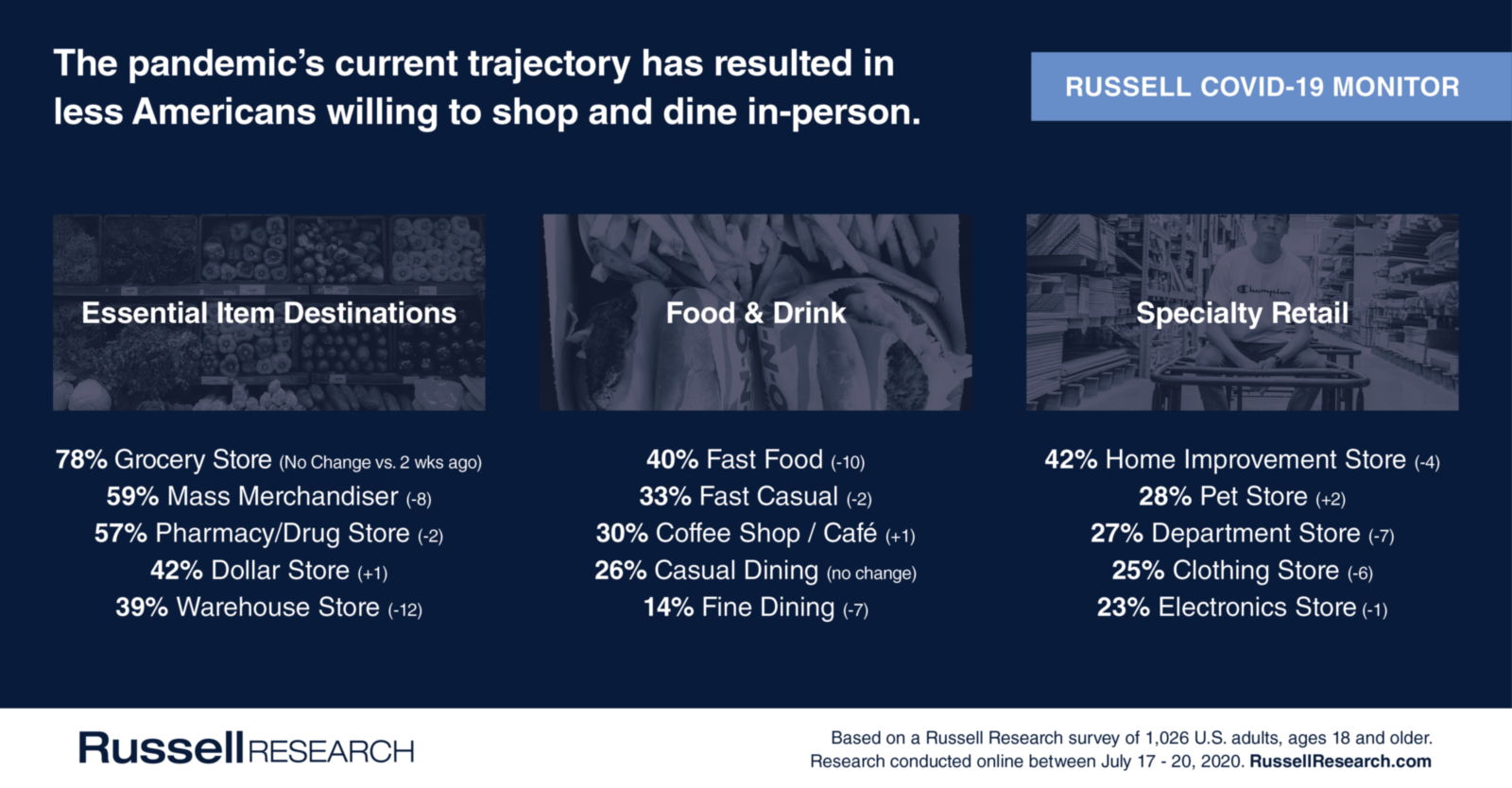COVID-19 & Its Impact on Everyday Life: July 17-20, 2020
The Russell COVID-19 Monitor finds 62% of Americans currently believing the pandemic is getting worse versus 20% who view the pandemic as improving. This is trending more negative compared to two weeks ago (58% worse / 23% better). 87% of Americans are now concerned about COVID-19, in line with findings over the past two months.
In recent weeks we have seen the trajectory of the pandemic trend negative without highly impacting behavior. Americans were slowly returning to many of the activities and shopping they enjoyed before COVID-19.
This is no longer the case. Outside of the most essential activities (e.g., grocery shopping) there have been sharp decreases in the percentage of Americans who plan to physically enter stores and restaurants in the coming weeks. Entertainment and travel are now more likely to be avoided in the near-term.
As a result, brands will need to lean back into the sales channels and fulfillment methods which made consumers safer over the past few months (e.g., digital, delivery, curbside pickup).
Consumers believe their new and/or modified behaviors will persist in the coming months. Nearly two-thirds of Americans believe this first wave of the pandemic will last for another 3+ months and more than one-quarter believe it will last 6+ months.
We also revisited face mask requirements in this week’s study. Many national retailers, including Walmart, Best Buy, and Starbucks, have required face masks in their retail locations. And there is a growing consensus among Americans that this is the correct policy. Over the past 4 weeks there has been a significant increase in the percentage of Americans who believe face masks should be required in a range of travel, shopping, dining, and entertainment settings.
Russell Research has interviewed over 16,000 Americans over the past 4 months about their coronavirus concerns and its impact on everyday behavior. Our COVID-19 Monitor will continue to evolve in the coming weeks as the situation changes. The study currently fields every other week with the next wave slated for July 31 – August 3, 2020.
Below are our key findings from July 17-20, 2020. Russell Research has tabulated data available for all 16,000+ interviews with several additional questions asked in the survey. Please email [email protected] for more information.
Views of the Current Situation
Most Americans remain concerned with COVID-19. Between July 17-20, 87% of Americans indicated they are concerned about coronavirus, compared to 84% two weeks earlier.
The perceived trajectory of COVID-19 continues to trend negative. 62% of Americans now believe the situation is getting worse, compared to 58% two weeks ago, and 39% four weeks ago. This belief is strongest in the West (68%) and South (65%).
20% of Americans feel that the current situation is getting better, compared to 23% two weeks ago, and 38% four weeks ago.
Impact on Behavior
Americans were slowly becoming more open to resuming a range of pre-pandemic activities in recent weeks. The change in the trajectory of the pandemic has reversed this trend.
Travel & Transportation
- 69% of Americans are less likely to fly on an airplane since the start of the pandemic (+6 percentage points vs. 2 weeks ago)
- 56% are less likely to stay at a hotel (no change)
- 62% are less likely to use public transportation (+4)
- 61% are less likely to go on a vacation (+5)
- 55% are less likely to use ride-sharing services (+7)
- 39% are less likely to rent a car (+3)
Entertainment & Shopping
- 71% of Americans are less likely to go to the movies (+6)
- 62% are less likely to go to a casino (+4)
- 59% are less likely to go to a shopping mall (+4)
The worsening of the pandemic has resulted in consumers reporting they are far less likely to consider shopping at mass merchandisers and dollar stores over the next month. However, this has not impacted shopping at essential destinations such as grocery stores and pharmacies.
Essential Item Destinations
- 78% of grocery shoppers intend to shop at a grocery store in the next month (no change vs. two weeks ago)
- 59% of category shoppers intend to shop at a mass merchandiser in the next month (-8)
- 57% of category shoppers intend to shop at a pharmacy or drug store in the next month (-2)
- 42% of category shoppers intend to shop at a warehouse store in the next month (+1)
- 39% of category shoppers intend to shop at a dollar store in the next month (-12)
Americans have gradually considered returning to fast food restaurants throughout June and early July. This sharply reversed with in-person visitation intent dropping 10 percentage points in the current wave.
Food & Drink
- 40% of category users intend to dine at a fast food restaurant in the next month (-10 percentage points vs. two weeks ago)
- 33% of category users intend to dine at a fast casual restaurant in the next month (-2)
- 30% of category users intend to go to a coffee shop or café in the next month (+1)
- 26% of category users intend to dine at a casual dining restaurant in the next month (no change)
- 14% of category users intend to dine at a fine dining restaurant in the next month (-7)
Most consumers are now increasingly avoiding in-person shopping at specialty retailers.
Clothing & Specialty Retail
- 42% of category shoppers intend to shop at a home improvement store in the next month (-4 percentage points vs. two weeks ago)
- 28% of category shoppers intend to shop at a pet store in the next month (+2)
- 27% of category shoppers intend to shop at a department store in the next month (-7)
- 25% of category shoppers intend to shop at a clothing store in the next month (-6)
- 23% of category shoppers intend to shop at an electronics store in the next month (-1)
- 20% of category shoppers intend to shop at an auto parts store in the next month (-6)
- 20% of category shoppers intend to shop at a shoe store in the next month (-1)
- 20% of category shoppers intend to shop at a home goods store in the next month (no change)
- 19% of category shoppers intend to shop at a sporting goods or outdoors store in the next month (-4)
This has led to Americans heading back to the safety-guided changes that were more prevalent in April and May.
- 61% of Americans are more likely to order online (+5 percentage points vs. 2 weeks ago)
- 52% are more likely to exercise at home (+6)
- 48% are more likely to order takeout or delivery (+2)
- 42% are more likely to stock up on household items (+2)
- 29% are more likely to have groceries delivered (+4)
- 20% are more likely to have medication delivered (+4)
Facemasks & Society
There has been a considerable shift over the past 4 weeks in the percentage of Americans who believe face masks should be required in a range of travel, shopping, dining, and entertainment settings.
- 76% of Americans believe face masks should be required on airplanes (+5 percentage points vs. 4 weeks ago)
- 76% believe face masks should be required in grocery stores (+7)
- 75% believe face masks should be required in movie theatres (+7)
- 74% believe face masks should be required in shopping malls (+8)
- 73% believe face masks should be required in large stores (+9)
- 73% believe face masks should be required in casinos (+8)
- 70% believe face masks should be required in convenience stores (+9)
- 69% believe face masks should be required in fast food restaurants (+10)
- 68% believe face masks should be required in hotels (+13)
The Long-Term
Most Americans believe this first wave of the pandemic will last for at least another 2 months and more than one-quarter think it will continue for more than 6 months.
- 7% of Americans believe the first wave of the pandemic will last less than 1 month
- 9% believe it will last for 1 more month
- 19% believe it will last for another 2 months
- 17% believe it will last for another 3 months
- 20% believe it will last for another 4-6 months
- 27% believe it will last for more than 6 months











